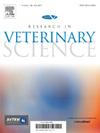Screening for Japanese Black cattle herds at risk of bovine leukemia virus transmission based on the presence of persistent lymphocytosis
IF 2.2
3区 农林科学
Q1 VETERINARY SCIENCES
引用次数: 0
Abstract
This study aimed to develop a screening method to identify Japanese Black (JB) cattle farms at high risk of bovine leukemia virus (BLV) transmission. We introduced a recently established lymphocyte count (LC) cut-off to detect cattle with persistent lymphocytosis (PL). To identify high-risk farms, we examined the relationship between the proportion of cattle with PL and the mean blood proviral loads (PVL) per farm. The results showed a strong correlation between the proportion of cattle with high LC, higher than the LC cut-off values for JB cattle, and the mean blood PVL per farm. This indicates that the mean blood PVL on a herd basis of JB cattle can be estimated from the proportion of cattle with high LC. Specifically, the mean blood PVL on farms with >30 % cattle having high LC was estimated to be greater than 100 copies/10 ng DNA. The higher the proportion of cattle with high LC per farm, the higher the proportion of cattle at risk as sources of BLV infection. The study demonstrated that the proportion of cattle with high LC, based on the new LC cut-off, serves as a practical index for screening high-risk farms with PL cattle that have high PVL. This finding is meaningful for prioritizing farms with a high proportion of cattle with high LC, necessitating BLV infection prevention measures, such as voluntary culling and segregation, in order to develop a regional, stepwise BLV eradication strategy.
根据持续淋巴细胞增多症筛查有牛白血病病毒传播风险的日本黑牛牛群
本研究旨在开发一种筛查方法,以确定存在牛白血病病毒(BLV)传播高风险的日本黑牛(JB)养殖场。我们采用最近确定的淋巴细胞计数(LC)临界值来检测患有持续性淋巴细胞增多症(PL)的牛。为了确定高风险牛场,我们研究了每个牛场患有持续性淋巴细胞增多症的牛的比例与平均血液病毒载量(PVL)之间的关系。结果显示,高LC(高于JB牛的LC临界值)牛的比例与每个农场的平均血液PVL之间存在很强的相关性。这表明,JB 牛群的平均血液 PVL 可以通过高 LC 牛的比例估算出来。具体来说,30%的牛有高LC,则农场的平均血液PVL估计大于100拷贝/10 ng DNA。每个农场高LC值牛的比例越高,作为BLV感染源的风险牛的比例就越高。研究表明,根据新的高LC临界值,高LC牛的比例可作为筛选拥有高PVL PL牛的高风险农场的实用指标。这一发现对于优先考虑高LC值牛比例较高的农场很有意义,因为这些农场需要采取BLV感染预防措施,如自愿扑杀和隔离,以制定区域性、渐进式的BLV根除战略。
本文章由计算机程序翻译,如有差异,请以英文原文为准。
求助全文
约1分钟内获得全文
求助全文
来源期刊

Research in veterinary science
农林科学-兽医学
CiteScore
4.40
自引率
4.20%
发文量
312
审稿时长
75 days
期刊介绍:
Research in Veterinary Science is an International multi-disciplinary journal publishing original articles, reviews and short communications of a high scientific and ethical standard in all aspects of veterinary and biomedical research.
The primary aim of the journal is to inform veterinary and biomedical scientists of significant advances in veterinary and related research through prompt publication and dissemination. Secondly, the journal aims to provide a general multi-disciplinary forum for discussion and debate of news and issues concerning veterinary science. Thirdly, to promote the dissemination of knowledge to a broader range of professions, globally.
High quality papers on all species of animals are considered, particularly those considered to be of high scientific importance and originality, and with interdisciplinary interest. The journal encourages papers providing results that have clear implications for understanding disease pathogenesis and for the development of control measures or treatments, as well as those dealing with a comparative biomedical approach, which represents a substantial improvement to animal and human health.
Studies without a robust scientific hypothesis or that are preliminary, or of weak originality, as well as negative results, are not appropriate for the journal. Furthermore, observational approaches, case studies or field reports lacking an advancement in general knowledge do not fall within the scope of the journal.
 求助内容:
求助内容: 应助结果提醒方式:
应助结果提醒方式:


